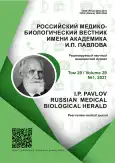煅烧主动脉瓣狭窄:外科治疗的机会和并发症
- 作者: Smirnova E.A.1,2, Terekhina A.I.1, Filonenko S.P.1, Muranchik E.N.3
-
隶属关系:
- Ryazan State Medical University
- Regional Clinical Cardiology Dispensary
- Ryazan Regional Clinical Cardiological Dispensary
- 期: 卷 29, 编号 1 (2021)
- 页面: 147-160
- 栏目: Reviews
- URL: https://journals.rcsi.science/pavlovj/article/view/34853
- DOI: https://doi.org/10.23888/PAVLOVJ2021291147-160
- ID: 34853
如何引用文章
详细
目的:严重主动脉瓣狭窄(AS)手术矫治方法选择的探讨。检查主动脉阀跨导管植入的读数、禁忌、优点和可能的并发症(TIAK)。描述临床病例,讨论不利的结果可能的原因。
主动脉狭窄是最常见的心脏病,其发病率随年龄增长而显著增加,在心脏外科适应证中占有首位。主动脉狭窄临床表现的一个特点是无症状期长,其持续时间因患者而异。自第一次出现临床表现以来,该病的预后急剧恶化。外科主动脉瓣置换术长期以来一直是治疗有症状主动脉狭窄患者的金标准。越来越多的老年人和伴有大量伴发疾病的老年患者,使用人工循环的介入治疗会增加术后并发症的风险,这已成为发展外科矫正AK病理学替代方法的决定性因素。
结论。TIAK目前比外科假肢具有显著优势,是老年患者的首选方法,用于治疗不能手术的患者,以及高、中、低手术风险的患者,需要多学科的方法。
作者简介
Elena Smirnova
Ryazan State Medical University; Regional Clinical Cardiology Dispensary
编辑信件的主要联系方式.
Email: smirnova-ea@inbox.ru
ORCID iD: 0000-0003-0334-6237
SPIN 代码: 6503-8046
Researcher ID: Y-1235-2018
MD, PhD, Associate Professor of the Department of Hospital Therapy with the Course of Medical and Social Expertise
俄罗斯联邦, Ryazan, RussiaAlena Terekhina
Ryazan State Medical University
Email: alenaterehina@mail.ru
ORCID iD: 0000-0002-2087-1458
SPIN 代码: 6812-1280
Researcher ID: AAN-9005-2020
6th-year Student of the General Medicine Faculty
俄罗斯联邦, Ryazan, RussiaSergey Filonenko
Ryazan State Medical University
Email: dr.filonenko@gmail.com
ORCID iD: 0000-0001-6658-2072
SPIN 代码: 1106-0648
Researcher ID: AAO-9466-2020
MD, PhD, Associate Professor of the Department of Hospital Therapy with the Course of Medical and Social Expertise
俄罗斯联邦, Ryazan, RussiaElena Muranchik
Ryazan Regional Clinical Cardiological Dispensary
Email: enmuranchik@yandex.ru
ORCID iD: 0000-0001-6375-6073
SPIN 代码: 8266-2535
Researcher ID: ААО-5677-2020
Cardiologist
俄罗斯联邦, Ryazan, Russia参考
- Lung B, Delgado V, Rosenhek R, et al. Contemporary Presentation and Management of Valvular Heart Disease The EURObservational Research Programme Valvular Heart Disease II Survey. Circulation. 2019;140(14):1156-69. doi: 10.1161/CIRCULATIONAHA.119.041080
- Aisling K, Annamalar M, Cusimano RJ, et al. Aortic Stenosis: Causes and Management. Journal of Cardiology & Cardiovascular Therapy. 2018;12 (1):555827. doi: 10.19080/JOCCT.2018.12.555827
- Akahori H, Tsujino T, Masuyama T, et al. Mechanisms of aortic stenosis. Journal of Cardiology. 2018;71(3):215-220. doi: 10.1016/j.jjcc.2017.11.007
- Dweck MR, Boon NA, Newby DE. Calcific aortic stenosis: a disease of the valve and the myocardium. Journal of the American College of Cardiology. 2012;60(19):1854-63. doi: 10.1016/j.jacc.2012.02.093
- Petrov VS, Zhdanov AI, Smirnova EA. Influence of aortal stenosis on manifestations of chronic rheumatic heart disease. Nauka Molodykh (Erudi-tio Juvenium). 2019;7(4):493-500. (In Russ). doi:10. 23888/HMJ201974493-500
- Baumgartner H, Falk V, Bax JJ, et al. ESC/EACTS Guidelines for the management of valvular heart disease. European Heart Journal. 2017;38(36): 2739-91. doi: 10.1093/eurheartj/ehx391
- Baumgartner H, Hung J, Bermejo J, et al. Recommendations on the Echocardiographic Assessment of Aortic Valve Stenosis: A Focused Update from the European Association of Cardiovascular Imaging and the American Society of Echocardiography. Journal of the American Society of Echocardiography. 2017;30(4):372-92. doi: 10.1016/j.echo.2017.02.009
- Harken DE, Soroff HS, Taylor WJ, et al. Partial and complete prostheses in aortic insufficiency. The Journal of Thoracic and Cardiovascular Surgery. 1960; 40(6):744-62. doi: 10.1016/S0022-5223(19)32572-3
- Sokolov VV, Parkhomenko MV, Kovalyov AI, et al. Comparative evaluation of aortic valve replacement methods in patients over 70 with aortic stenosis. Russian Sklifosovsky Journal of Emergency Medical Care. 2018;7(3):227-33. (In Russ). doi:10.23934/ 2223-9022-2018-7-3-227-233
- Borger MA, Moustafine V, Conradi L, et al. A randomized multicenter trial of minimally invasive rapid deployment versus conventional full sternotomy aortic valve replacement. The Annals of Thoracic Surgery. 2015;99(1):17-25. doi:10.1016/j. athoracsur.2014.09.022
- Gilmanov D, Miceli A, Ferrarini M, et al. Aortic Valve Replacement Through Right Anterior Minithoracotomy: Can Sutureless Technology Improve Clinical Outcomes? The Annals of Thoracic Surgery. 2014;98(5):1585-92. doi: 10.1016/j.athoracsur. 2014.05.092
- Phan K, Tsai Y-C, Niranjan N, et al. Sutureless aortic valve replacement: a systematic review and metaanalysis. Annals of Cardiothoracic Surgery. 2014; 4(2):100-11. doi: 10.3978/j.issn.2225319X.2014.06.01
- Cribier A, Savin T, Saoudi N, et al. Percutaneous transluminal valvuloplasty of acquired aortic stenosis in elderly patients: an alternative to valve replacement? Lancet. 1986;326(8472):63-7. doi:10.1016/ S0140-6736(86)90716-6
- Andersen HR, Knudsen LL, Hasenkam JM. Transluminal implantation of artificial heart valves. Description of a new expandable aortic valve and initial results with implantation by catheter technique in closed chest pigs. European Heart Journal. 1992;13(5):704-8. doi: 10.1093/oxfordjournals. eurheartj.a060238
- Cribier A, Eltchaninoff H, Bash A, et al. Percutaneous transcatheter implantation of an aortic valve prosthesis for calcific aortic stenosis: first human case description. Circulation. 2002;106(24):30068. doi: 10.1161/01.CIR.0000047200.36165.B8
- Paniagua D, Condado JA, Besso J, et al. First human case of retrograde transcatheter implantation of an aortic valve prosthesis. Texas Heart Institute Journal. 2005;32(3):393-8.
- Imaev TE, Komlev AE, Akchurin RS. Transcatheter aortic valve implantation. State of the problem and prospects in Russia. Rational Pharmacotherapy in Cardiology. 2015;11(1):53-9. (In Russ). doi: 10.20996/1819-6446-2015-11-1-53-59
- Belyaev SA, Leont'ev SA, Mohr F-W. Transcatheter aortic valve implantation. Creative Cardiology. 2015;(4):25-33. doi: 10.15275/kreatkard.2015.04.03
- Siontis GCM, Overtchouk P, Cahill TJ, et al. Transcatheter aortic valve implantation vs. surgical aortic valve replacement for treatment of symptomatic severe aortic stenosis: an updated metaanalysis. European Heart Journal. 2019;40(38): 3143-53. doi: 10.1093/eurheartj/ehz275
- Nishimura RA, Otto CM, Bonow RO, et al. 2017 AHA/ACC focused update of the 2014 AHA/ACC guideline for the management of patients with valvular heart disease: A report of the American Col-lege of Cardiology/American Heart Association task force on clinical practice guidelines. Journal of the American College of Cardiology. 2017;70(2): 252-89. doi: 10.1016/j.jacc.2017.03.011
- Kapadia SR, Leon MB, Makkar RR, et al. 5-year outcomes of transcatheter aortic valve replacement compared with standard treatment for patients with inoperable aortic stenosis (PARTNER 1): a randomised controlled trial. Lancet. 2015;385(9986): 2485-91. doi: 10.1016/S0140-6736(15)60290-2
- Smith CR, Leon MB, Mack MJ, et al. Transcatheter versus surgical aortic-valve replacement in high-risk patients. The New England Journal of Medicine. 2011;364(23):2187-98. doi: 10.1056/NEJMoa 1103510
- Leon MB, Smith CR, Mack MJ, et al. Transcatheter or Surgical Aortic-Valve Replacement in Inter-mediate-Risk Patients. The New England Journal of Medicine. 2016;374(17):1609-20. doi: 10.1056/NEJ Moa1514616
- Webb JG, Wood DA, Ye J, et al. Transcatheter valve-in-valve implantation for failed bioprosthetic heart valves. Circulation. 2010;121(16):1848-57. doi: 10.1161/CIRCULATIONAHA.109.924613
- Thyregod HGH, Ihlemann N, Jørgensen TH, et al. Five-year clinical and echocardiographic outcomes from the Nordic aortic valve intervention (NO-TION) randomized clinical trial in lower surgical risk patients. Circulation. 2019;139(24):2714-23. doi: 10.1161/CIRCULATIONAHA.118.036606
- Margolina AA, Gruzdev KA, Lepilin MG, et al. Complications after transcatheter aortic valve implantation. Kardiologiia. 2016;56(2):35-9. (In Russ). doi:10.18565/ cardio.2016.2.35-39
- Ribeiro HB, Nombela-Franco L, Urena M, et al. Coronary obstruction following transcatheter aortic valve implantation: a systematic review. JACC Cardiovascular Interventions. 2013;6(5):452-61. doi: 10.1016/j.jcin.2012.11.014
补充文件






